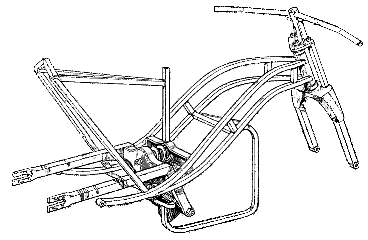 Go
to the Archive index
Go
to the Archive indexThe most distinctive of the Villiers 2F powered autocycles, the sole example of the Commander I was built by the General Steel Group (part of EMI) at Springfield Road, Hayes (Commander II and Commander III were, respectively, 98cc and 122cc motor cycles based on the same frame design). The ‘works’ of Commander I were fairly conventional: a Villiers 2F engine, 4-inch [102mm] drum brakes front & rear, Dunlop 2.25×21 tyres. However, the frame was fabricated from square-section tubing and was totally enclosed in steel pressings.

The leading link front suspension used rubber bands as the suspension medium and the rear suspension - a unique feature on a British autocycle - used a single coil spring giving 4½ inches [114mm] total travel. The colour scheme was ivory and light blue, with a blue saddle to match the bodywork. There were copious amounts of chromium plate, including the large cage that enclosed the engine, and not only the wheel rims but the hubs and back plates too. The handlebar levers were the inverted type and controlled the clutch and front brake. The rear brake was applied by back-pedalling. A knob on the right side of the body controlled the fuel tap and another knob on the left could be pulled to close the choke or twisted to ‘tickle’ the carburettor. The direct lighting set was styled to match the bodywork and was controlled by a handlebar switch. A tool kit and tyre pump were housed in a compartment below the saddle. Despite the enclosure, access to the engine was simple, a sixpence being the only tool required.
The entire Commander range was on show at the Earls Court show in 1952. After the Earls Court Show, the Commanders were put on display at the Edgeware Road Showrooms of Marble Arch Motor Supplies. In December 1952 Marble Arch advertised the Commander range; their cash price for an autocycle was £74 19s 6d.
The final reference to the Commander range in the motor cycling weeklies was on 16th April 1953. The Motor Cycle “Lightweight Buyers’ Guide” did not, however, list the autocycle - a larger Commander 4 had taken its place. Because of a reduction in Purchase Tax on motor cycles in the 1953 Budget, The Motor Cycle had to list revised prices in the following week’s edition. The entire Commander range had been quietly dropped from this list.
|
||||||
The next article in this series will describe the Coventry Eagle autocycle.
First published - June 1998